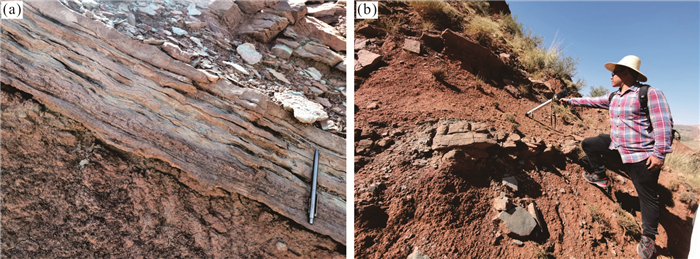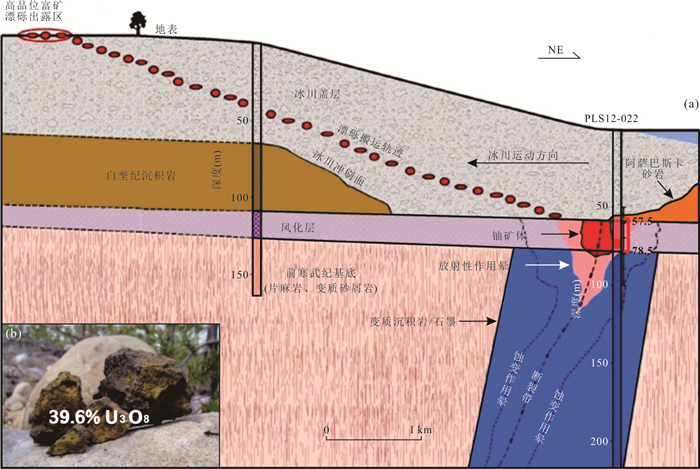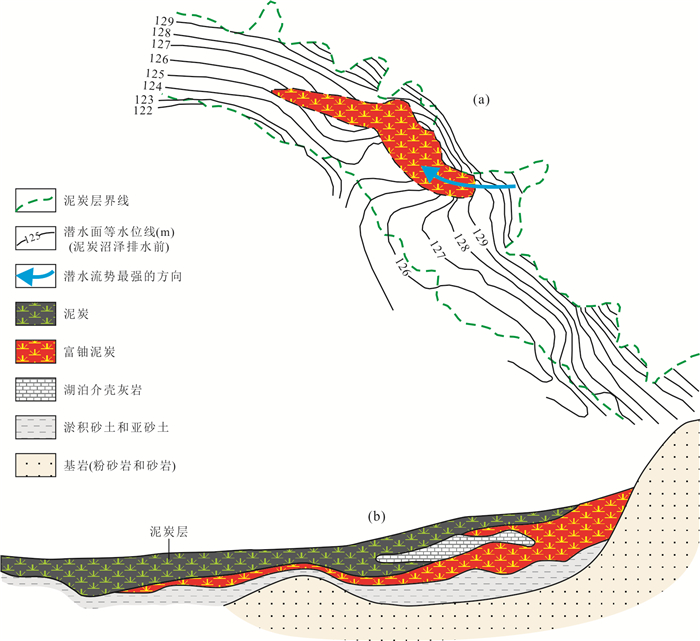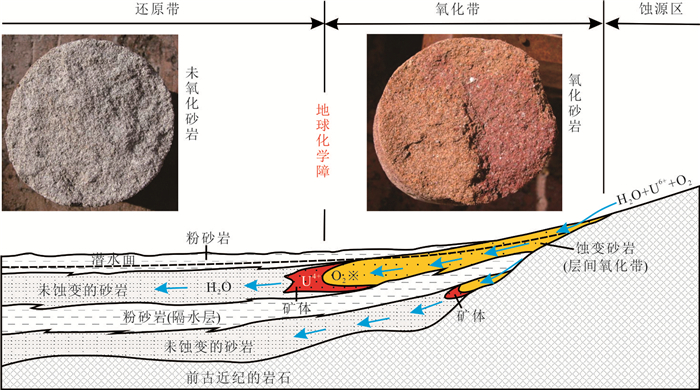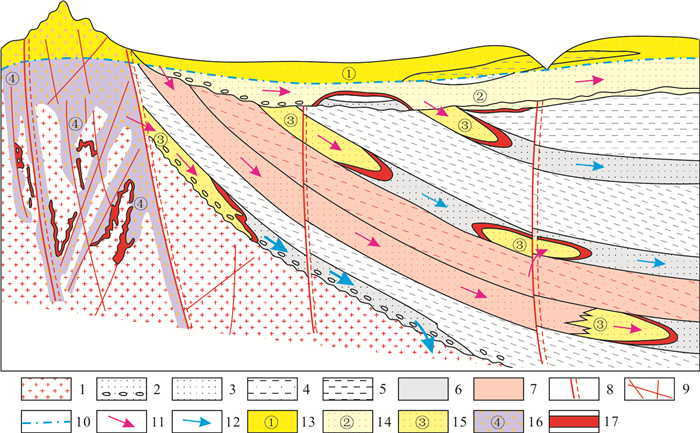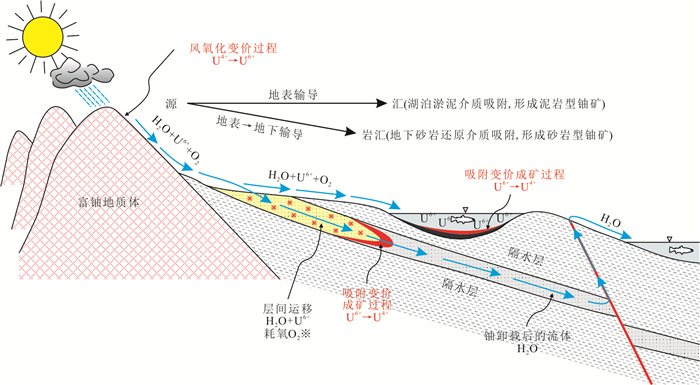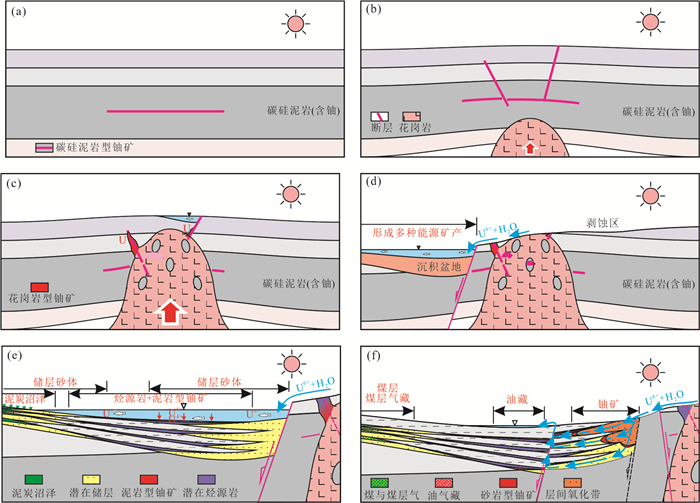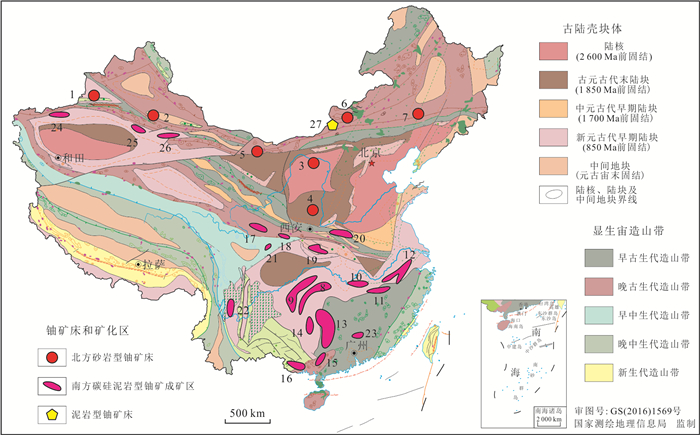Review of Basin Uranium Resources in China
-
摘要: 近20多年来,我国在北方6大沉积盆地中陆续发现了系列大型和超大型砂岩型铀矿床,丰富的资源量昭示了沉积盆地是一个巨大的促使铀汇聚的化学反应器.然而,盆地中的铀矿床类型远不止于砂岩型一种,它们一并构成了宝贵的盆地铀资源.将在沉积盆地发展演化过程中,受沉积、成岩和构造作用制约而促使铀富集形成的系列铀矿床,统称为盆地铀资源.充分考虑铀成矿作用的关键制约要素和矿床形成的发育时序,将盆地铀资源划分为同沉积型、不整合型和成岩型三大类13个亚类型矿床.在盆山耦合的构造体制驱动下,铀的变价属性是铀大尺度循环(汇聚与分散)的基础,这使得各种铀矿床之间既具有成因联系又能相互转化.我国已探明盆地铀资源的矿床成因类型、时空分布和资源量规模极不均衡,但是北方砂岩型铀矿床和南方碳硅泥岩型铀矿床构成了盆地铀资源的主体,从而具有“一北一南”、“一陆一海”、“一新一老”的基本格局.目前,北方砂岩型铀矿是我国勘查和开发的重点,然而铀储层结构和物质成分的非均质性极大,地浸采铀技术亟需革新以适宜多数砂岩型铀矿床的开发.同时,需要在新地区、新层位发现更多新类型铀矿床,还需要依赖技术研发盘活已发现的以南方碳硅泥岩型铀矿床为代表的“超低孔渗”、“富有机质”、“深埋藏”的系列“呆矿”.Abstract: In the past 20 years,a series of large and super-large sandstone type uranium deposits have been discovered in six sedimentary basins in the northern China. The abundant uranium resources indicate that the sedimentary basin is a huge chemical reactor for uranium concentration. However,the types of uranium deposits in the basin are far more than sandstone type,which together constitute valuable uranium resources in the basin. In the course of development and evolution of sedimentary basins,a series of uranium deposits restricted by sedimentation,diagenesis and tectonism are collectively referred to as basin uranium resources. Fully considering the key constraints of uranium mineralization and the development sequence of deposit formation,the uranium resources in the basin can be divided into three categories,i.e.,synsedimentary type,unconformity type and diagenetic type,and 13 subtypes. Driven by the tectonic system of basin mountain coupling,the variable valence property of uranium is the basis of large-scale uranium cycle (convergence and dispersion),which makes various uranium deposits have genetic connection and mutual transformation. The genetic type,spatial and temporal distribution and resource scale of uranium resources in proven basins in China are extremely unbalanced. However,uranium resources in the basin show the basic pattern of "one north and one south","one land and one sea" and "one new and one old",with sandstone type uranium deposits dominating in the north and carbonaceous siliceous mudstone type uranium deposits dominating in the south. At present,sandstone type uranium deposits in northern China are the focus of exploration and development in China. However,the heterogeneity of uranium reservoir structure and material composition requires that in-situ leaching uranium mining technology needs to be innovated to suit the development of most sandstone type uranium deposits. At the same time,it needs to find more new types of uranium deposits in new areas and new horizons,and needs to rely on technological research and development to activate the discovered series dead mines of "ultra-low porosity and ultra-low permeability","rich organic matter" and "deep buried depth" represented by the southern carbonaceous siliceous mudstone type uranium deposits.
-
图 1 二连盆地西部努和廷同沉积泥岩型铀矿床
据焦养泉等(2015a, 2015b)修改. a. 湖泊相富分散有机质和黄铁矿的含石膏泥岩(铀矿石);b. 小层序中铀矿化与湖泊扩展事件关系;c. 湖泊扩展体系域与含矿性叠合图,显示铀矿化与湖泊中心及其伴生的三角洲前缘关系密切;d. 湖泊扩展体系域发育时期的铀成矿模式
Fig. 1. Nuheting synsedimentary mudstone type uranium deposit in western Erlian Basin
图 2 塔里木盆地库车坳陷西北缘卡拉布拉克浊积岩型铀矿点野外露头
据焦养泉等(2020). a. 夹于红色泥岩中的浊积岩(极细砂岩);b. 薄层席状铀矿体(放射性为840×10-6),红色泥岩(放射性为210×10-6~230×10-6)
Fig. 2. Kalabulake turbidite type uranium deposit in northwest margin of Kuqa Depression, Tarim Basin
图 3 阿萨巴斯卡盆地帕特森湖南高品位富矿冰川漂砾与原生不整合型铀矿床关系
据Ainsworth et al.(2012). a. 不同性质铀矿的成因关系剖面图;b. 地表出露的高品位富矿冰川漂砾
Fig. 3. Relationship between glacial boulders in high grade rich ores and primary uranium deposits in Paterson, Athabasca Basin
图 4 泥炭田铀矿化的现代实例
据Kochenov et al.(1965). a. 泥炭田中矿化的平面分布;b. 通过泥炭田的沉积剖面
Fig. 4. A modern example of uranium mineralization in peat fields
图 5 层间氧化带型砂岩铀矿成矿模式(据Harshman,1972修改)
Fig. 5. Metallogenic model of interlayer oxidation zone type sandstone uranium deposit (modified from Harshman, 1972)
图 6 不同类型的氧化带及其与外生后成铀矿化的关系
据Максимова and Шмариович(1993). 1.基底岩石;2.细砾石;3.砂岩;4.粉砂岩;5.粘土;6.含碳质碎屑的原生灰色岩石;7.原生红色岩石;8.断裂;9.多裂隙带;10.地下水位;11.含氧含铀地下水运动方向;12.无氧、不含铀地下水运动方向;13.地表氧化带;14.孔隙潜水氧化带;15.孔隙层间水氧化带;16.裂隙水氧化带;17.铀矿化
Fig. 6. Different types of oxidation zones and their relationship with exogenic-epigenetic uranium mineralization
图 8 地壳演化过程中各类铀矿床相互转化机理与过程示意
据焦养泉等(2020). a. 富铀的碳硅泥岩和碳硅泥岩型铀矿形成;b. 岩浆侵位并远程波及影响到碳硅泥岩型铀矿床;c.岩浆继续侵位,吞食碳硅泥岩型铀矿和富铀碳硅泥岩,导致富铀岩浆形成,并在有利的构造和环境中形成花岗岩型铀矿;d. 区域构造变革,花岗岩体及围岩地层遭受抬升剥蚀沦为蚀源区,各种铀被氧化为U6+,同时新的沉积盆地形成;e. 借助水系U6+被输送到湖盆,在湖泊底部U6+被富有机质泥岩(潜在烃源岩)吸附还原成U4+而形成泥岩型铀矿,与此同时在盆缘形成潜在的储层砂岩,并在适当的古气候条件下发育泥炭沼泽;f. 盆地进一步埋深和演化,有机质成熟形成煤层、煤层气,烃源岩排烃形成油藏,盆缘发生表生成岩作用(层间氧化作用)而形成砂岩型铀矿,从而构成多种能源矿产同盆共存富集的基本格局
Fig. 8. Mutual transformation mechanism and process of various uranium deposits during crustal evolution
图 9 中国主要盆地铀资源分布的基本格局及其与岩石圈板块构造关系
北方陆相盆地砂岩型铀矿床:1.伊犁盆地南缘铀矿田;2.吐哈盆地南缘十红滩铀矿床;3.鄂尔多斯盆地北部东胜铀矿田;4.鄂尔多斯盆地南部店头-双龙铀矿床;5.巴音戈壁盆地塔木素铀矿床;6.二连盆地巴彦乌拉铀矿田;7.松辽盆地钱家店铀矿田. 南方海相盆地碳硅泥岩型铀矿成矿区:8.雪峰山;9.黔中-川东南;10.幕阜山-修水;11.丰城-上饶;12.皖南-浙西北;13.湘中;14.越城岭-苗儿山;15.大容山;16.西大明山;17.若尔盖;18.洛阳;19.安康-桂平;20.豫中成矿区;21龙门山;22.康滇地轴南部;23.信丰;24.柯坪;25.库鲁克塔格;26.马鬃山. 北方陆相盆地泥岩型铀矿床:27.二连盆地努和廷铀矿床. 铀矿床和成矿区资料据赵凤民(2012)和焦养泉等(2015a)修编;岩石圈板块构造图据马丽芳(2002)简化
Fig. 9. Basic distribution pattern of uranium resources in major basins of China and its relationship with lithospheric plate tectonics
表 1 盆地铀资源的成因分类
Table 1. Genetic classification of uranium resources in basins
成因类型 高级
控制因素低级控制因素 盆地铀资源亚类型 国内外典型矿床实例 同沉积型 古环境古气候 湖泊环境+干旱气候 湖水型铀矿 塔吉克斯坦萨瑟库里湖矿床 湖泊环境+干旱气候+暗色淤泥(强还原剂) 泥岩型铀矿 二连盆地努和廷铀矿床、潮水盆地大红山铀矿床 干旱气候 钙结岩型铀矿 澳大利亚伊利里铀矿床、纳米比亚兰格海因里希铀矿床、我国西北地区矿化点 沉积搬运作用 缺氧环境+水道搬运沉积 石英砾岩型铀矿 南非维特沃特斯兰德盆地的德里霍特恩金-铀矿床、加拿大的布兰德河-艾利奥特湖铀矿床 冰川搬运沉积 冰碛岩型铀矿 加拿大阿萨巴斯卡盆地帕特森湖白垩纪冰碛砾岩转石堆积铀矿床 生物沉积作用 低等生物遗体大量堆积+滨浅海环境+水体缺氧硫化事件 碳硅泥岩型铀矿(大部分经历了后期的浅变质、构造和盆地热流体叠加改造) 若尔盖铀矿田 磷块岩型铀矿 贵州铜仁坝黄铀矿床、金沙岩孔铀矿床 鱼骨化石沉积物+滨浅海环境 鱼骨-磷酸盐型铀矿 哈萨克斯坦里海东北部麦洛沃耶矿床等 沉积环境变化+物源供给变化 煤岩型铀矿(泥炭沼泽形成过程中富集成矿) 不整合型 沉积间断
不整合界面盆地(热)流体+石墨(还原介质) 不整合型铀矿(原矿与石墨有关) 加拿大北萨斯喀彻温铀矿省雪茄湖铀矿床、澳大利亚北部派因-克里克铀矿省兰杰铀矿床 成岩型 表生成岩作用
(后生蚀变作用)
(水-岩作用)
(氧化-还原环境)砂岩型铀矿(水成铀矿) 层间渗入氧化型 伊犁铀矿田、十红滩铀矿床、巴彦床乌拉铀矿田、钱家店铀矿田、巴音戈壁铀矿田 潜水氧化型 测老庙铀矿床 古河谷型 俄罗斯外乌拉尔铀矿田、西西伯利亚铀矿田 构造-岩性型 法国Lodève盆地Mas Lavayre铀矿床、加蓬奥克洛铀矿床 元古代与岩墙群有关的砂岩铀矿 澳大利亚Westmoreland铀矿田、澳大利亚Alligator Rivers铀矿田、加拿大Otish盆地Matoush铀矿床 古砂岩型铀矿(古层间渗入氧化型)(成矿较早,经历后期改造) 鄂尔多斯盆地东胜铀矿田、塔里木盆地西北缘萨瓦甫齐铀矿床 表 2 古气候的变迁与铀循环的关系(据毛裕年和闵永明,1989)
Table 2. Relationship between paleoclimate change and uranium cycle (according to Mao and Min, 1989)
气候类型 铀的活化与浸出 铀的迁移与沉淀 炎热潮湿 风化强烈,铀易被大量浸出,形成很厚的风化壳 水量充沛,铀被带至海区;气温高,有机质和硫化物易氧化,铀以吸附或还原方式固定 干旱 化学风化微弱,以物理风化为主;环境氧化,水分不足,使铀的浸出受到影响 整体氧化背景中存在局部还原场,易造成铀的富集;碱性地球化学环境易形成铀黑 温和潮湿 热量不足,化学风化受到限制而影响铀的浸出 风化壳为酸性,易形成次生铀矿物;水量充沛,铀在介质中矿化度降低 干冷 以物理风化为主,铀难以被浸出 气温低,有机质氧化缓慢,易呈铀酰络合物稳定迁移,使铀沉淀受到影响 -
Ainsworth, G. P., McElroy, R., Ashley, R., et al., 2012. A Convenient Joint Venture-Patterson Lake South. Saskatchewan Geological Open House 2012. Saskatchewan Ministry of the Economy, Saskatoon. Alexandre, P., Kyser, K., Polito, P., et al., 2005. Alteration Mineralogy and Stable Isotope Geochemistry of Paleoproterozoic Basement-Hosted Unconformity-Type Uranium Deposits in the Athabasca Basin, Canada. Economic Geology, 100(8): 1547-1563. https://doi.org/10.2113/gsecongeo.100.8.1547 Bergen, L., Fayek, M., 2012. Petrography and Geochronology of the Pele Mountain Quartz-Pebble Conglomerate Uranium Deposit, Elliot Lake District, Canada. American Mineralogist, 97(8-9): 1274-1283. https://doi.org/10.2138/am.2012.4040 Catuneanu, O., Martins-Neto, M. A., Eriksson, P. G., 2005. Precambrian Sequence Stratigraphy. Sedimentary Geology, 176(1-2): 67-95. https://doi.org/10.1016/j.sedgeo.2004.12.009 Chen, D.S., Wang, R.Y., Li, S.X., 1997. Metallogenic Model of the Sandstone-Type Uranium Deposits in Interlayer Oxidation Zone of Yili Basin. Uranium Geology, 13(6): 327-335 (in Chinese with English abstract). http://en.cnki.com.cn/Article_en/CJFDTOTAL-YKDZ199706001.htm Chen, Y. L., 2008. The Study on Ore-Forming Fluid Genesis and Ore-Forming Model of Carbonaceous-Siliceous-Argillitic Rock Type Uranium Deposit in Zoige Region (Dissertation). Chengdu University of Technology, Chengdu (in Chinese with English abstract). Chen, Z.B., Li, S.X., Cai, Y.Q., et al., 2002. Geologic Evolution and Uranium Metallogenic Regularity in Yili Basin. Mineral Deposits, 21(S1): 849-852 (in Chinese with English abstract). Chen, Z. B., Zhao, F. M., 2002. Formation Model of Leachable Uranium Deposits and Its Prospecting Prospects in China. Overseas Uranium and Gold Geology, 19(3): 127-133 (in Chinese). Chen, Z.Y., 2002. Regional Distribution Regularity of Sandstone Uranium Deposits in Asian Continent and Prospecting Strategy for Sandstone Uranium Deposits in China. Uranium Geology, 18(3): 129-137 (in Chinese with English abstract). http://d.wanfangdata.com.cn/periodical/ykdz200203001 Chen, Z. Y., Chen, D. S., Gu, K. H., 2011. China's Uranium Deposit Research Evaluation (Volume Ⅲ: Sandstone Type Uranium Deposits). China Nuclear Geology and Beijing Research Institute of Uranium Geology, Beijing (in Chinese). Cheng, L. W., Du, Q. K., Wu, J. S., et al., 2012. The Practice and Enlightenment of "Simultaneous Exploration of Coal and Uranium" in Daying Uranium Mine. China Nuclear Industry, (S1): 1-105 (in Chinese). Dahlkamp, F. J., 1991. Uranium Ore Deposits. Springer-Verlag, Heidelberg. Dahlkamp, F. J., 2009. Uranium Deposits of the World: Asia. Springer-Verlag, Heidelberg. Du, L. T., Wang, W. G., Liu, Z. Y., 2011. Research and Evaluation of Uranium Deposits in China (Volume I: Evaluation of Granite Type Uranium Deposits). China Nuclear Geology and Beijing Research Institute of Uranium Geology, Beijing (in Chinese). Galloway, W. E., Hobday, D. K., 1983. Terrigenous Clastic Depositional Systems-Applications to Petroleum, Coal, and Uranium Exploration. Springer-Verlag, Heidelberg. Guo, M., Zhang, X.Q., Wang, Y.Y., 2018. A Comparative Study of U-Mineralization and Petrological Geochemistry Characteristics between the Baimadong U-Hg-Mo Deposit and the Jinsha Rock Bore Phosphorite in Guizhou Province. China's Manganese Industry, 36(1): 58-61 (in Chinese with English abstract). http://en.cnki.com.cn/Article_en/CJFDTOTAL-ZGMM201801017.htm Han, J., Wang, Z.M., Hao, W.L., et al., 2011. Preliminary Discussions on Uranium Enrichment in Typical Saline Lakes in Northwestern China. Uranium Geology, 27(3): 160-165 (in Chinese with English abstract). http://en.cnki.com.cn/Article_en/CJFDTOTAL-YKDZ201103005.htm Hao, W.L., Wang, Z.M., Lin, X.B., et al., 2018. Distribution Characteristics of Uranium Bearing Saline Lake in China. Uranium Geology, 34(1): 60-64 (in Chinese with English abstract). http://en.cnki.com.cn/Article_en/CJFDTotal-YKDZ201801010.htm Harshman, E. N., 1972. Geology and Uranium Deposits, Shirley Basin Area, Wyoming. U.S. Geological Survey, Washington, D.C. . Huang, D.Y., Wang, S.L., Mao, J.X., et al., 2015. Preliminary Study on the Uranium Source of Zabuye Salt Lake, Tibet. Uranium Geology, 31(3): 389-394 (in Chinese with English abstract). http://en.cnki.com.cn/Article_en/CJFDTotal-YKDZ201503006.htm Huang, J. B., Fang, X. H., Xie, Y. X., 2011. Research and Evaluation of Uranium Deposits in China (Volume II: Evaluation of Volcanic Type Uranium Deposits). China Nuclear Geology and Beijing Research Institute of Uranium Geology, Beijing (in Chinese). Huang, J.B., Huang, S.J., 2005. Regional Metallogenic Characteristics of China's Uranium Resources. Uranium Geology, 21(3): 129-138 (in Chinese with English abstract). http://en.cnki.com.cn/Article_en/CJFDTOTAL-YKDZ200503001.htm Huang, J.B., Li, S.X., 2007. Metallogenic Characteristics, Model and Exploration Prospect for the Paleo-Interlayer-Oxidation Type Sandstone-Hosted Uranium Deposits in China. Uranium Geology, 23(1): 7-16 (in Chinese with English abstract). http://en.cnki.com.cn/Article_en/CJFDTOTAL-YKDZ200701001.htm Huang, K.P., Zheng, M.R., 2012. Analysis on Exploration Prospecting of Phosphorite Unconventional Uranium Resource in Guizhou. Guizhou Geology, 29(3): 179-182 (in Chinese with English abstract). http://en.cnki.com.cn/Article_en/CJFDTOTAL-GZDZ201203006.htm Huang, K.P., Zheng, M.R., Sun, P.M., et al., 2018. Geochemical Characteristics of the Bahuang Uranium Deposit in the Eastern Guizhou and Their Constraints on the Sedimentary Environment of the Phosphorite. Bulletin of Mineralogy, Petrology and Geochemistry, 37(2): 334-343 (in Chinese with English abstract). http://en.cnki.com.cn/Article_en/CJFDTotal-KYDH201802018.htm Huang, S.H., Qin, M.K., Xu, Q., et al., 2019. Hydrocarbon Fluid Geological Characteristics of the Xishanyao Formation and Its Uranium Metallogenic Significance, Northwest Junggar Basin. Earth Science, 44(9): 3060-3073 (in Chinese with English abstract). http://en.cnki.com.cn/Article_en/CJFDTotal-DQKX201909021.htm Huang, S.J., 1994. Formation Conditions and Prospecting Criteria for Sandstone Uranium Deposit of Interlayered Oxidation Type. Uranium Geology, 10(1): 6-13 (in Chinese with English abstract). http://www.cnki.com.cn/Article/CJFDTotal-YKDZ401.001.htm IAEA, 2018. Geological Classification of Uranium Deposits and Description of Selected Examples. OECD, Vienna. Jiao, Y.Q., Chen, A.P., Wang, M.F., et al., 2005. Genetic Analysis of the Bottom Sandstone of Zhiluo Formation, Northeastern Ordos Basin: Predictive Base of Spatial Orientation of Sandstone-Type Uranium Deposit. Acta Sedimentologica Sinica, 23(3): 371-379 (in Chinese with English abstract). http://d.wanfangdata.com.cn/Periodical/cjxb200503001 Jiao, Y. Q., Wang, S. M., Wang, H., et al., 2020. Mineral Resources in Coal Measures. China University of Geosciences Press, Wuhan (in Chinese). Jiao, Y.Q., Wu, L.Q., Peng, Y.B., et al., 2015a. Sedimentary-Tectonic Setting of the Deposition-Type Uranium Deposits Forming in the Paleo-Asian Tectonic Domain, North China. Earth Science Frontiers, 22(1): 189-205 (in Chinese with English abstract). http://www.researchgate.net/publication/281907888_Sedimentary-tectonic_setting_of_the_deposition-type_uranium_deposits_forming_in_the_Paleo-Asian_tectonic_domain_North_China Jiao, Y. Q., Wu, L. Q., Rong, H., 2015b. Sedimentology of Coal-Bearing Basins. China University of Geosciences Press, Wuhan (in Chinese). Jiao, Y.Q., Wu, L.Q., Rong, H., 2018a. Model of Inner and Outer Reductive Media within Uranium Reservoir Sandstone of Sandstone-Type Uranium Deposits and Its Ore-Controlling Mechanism: Case Studies in Daying and Qianjiadian Uranium Deposits. Earth Science, 43(2): 459-474 (in Chinese with English abstract). Jiao, Y.Q., Wu, L.Q., Rong, H., et al., 2018b. Geological Modeling of Uranium Reservoir: The Geological Foundation of Revealing the Metallogenic Mechanism and Solving "Remaining Uranium". Earth Science, 43(10): 3568-3583 (in Chinese with English abstract). http://www.researchgate.net/publication/329984011_Geological_Modeling_of_Uranium_Reservoir_The_Geological_Foundation_of_Revealing_the_Metallogenic_Mechanism_and_Solving_Remaining_Uranium Jiao, Y. Q., Wu, L. Q., Rong, H., et al., 2021. Heterogeneous Geological Modeling of Uranium Reservoir: A Sedimentology Basis for Revealing Uranium Metallogenic Mechanism and Enhancing Uranium Recovery in Zhiluo Formation in Ordos Basin. China University of Geosciences Press, Wuhan (in Chinese). Jiao, Y. Q., Wu, L. Q., Wang, M. F., et al., 2005. Forecasting the Occurrence of Sandstone-Type Uranium Deposits by Spatial Analysis: An Example from the Northeastern Ordos Basin, China. In: Mao, J., Bierlein, F.P., eds., Mineral Deposit Research: Meeting the Global Challenge. Springer, Berlin, Heidelberg, 273-275. https://doi.org/10.1007/3-540-27946-6_71 Jiao, Y. Q., Wu, L. Q., Yang, S. K., et al., 2006. Sedimentology of Uranium Reservior: The Foundation of Sandstone Type Uranium Deposit Exploration and Development. Geological Publishing House, Beijing (in Chinese). Jin, Y.Z., Tian, W.H., 2011. An Analysis of Metallogenic Conditions and Resource of the Zoige Uranium Deposit. Geology in China, 38(3): 681-691 (in Chinese with English abstract). http://en.cnki.com.cn/Article_en/CJFDTOTAL-DIZI201103015.htm Jolley, S. J., Freeman, S. R., Barnicoat, A. C., et al., 2004. Structural Controls on Witwatersrand Gold Mineralisation. Journal of Structural Geology, 26(6-7): 1067-1086. https://doi.org/10.1016/j.jsg.2003.11.011 Kochenov, A. V., Zinev'yev, V. V., Lovaleva, S. A., 1965. Some Features of the Accumulation of Uranium in Peat Bogs. Geochemistry International, 2(1): 65-70. http://www.researchgate.net/publication/285099372_Some_features_of_the_accumulation_of_uranium_in_peat_bogs Lesbros-Piat-Desvial, M., Beaudoin, G., Mercadier, J., et al., 2017. Age and Origin of Uranium Mineralization in the Camie River Deposit (Otish Basin, Québec, Canada). Ore Geology Reviews, 91: 196-215. https://doi.org/10.1016/j.oregeorev.2017.10.006 Li, K.R., 1990. Feature of Uranium Mineralization and Mineral-Formation Condition of Callche Type in Northwest. Journal of East China Institute of Technology, 13(2): 24-30 (in Chinese with English abstract). Ling, H.F., 2011. Origin of Hydrothermal Fluids of Granite-Type Uranium Deposits: Constraints from Redox Conditions. Geological Review, 57(2): 193-206 (in Chinese with English abstract). http://www.researchgate.net/publication/284593905_Origin_of_hydrothermal_fluids_of_granite-type_uranium_deposits_constraints_from_redox_conditions Liu, C. Y., 2005. Research Progress on the Coexistence and Enrichment of Multi-Energy Minerals in the Basin. Science Press, Beijing (in Chinese). Ma, L. F., 2002. Geological Atlas of China. Geological Publishing House, Beijing (in Chinese). Manzi, M. S. D., Hein, K. A. A., Durrheim, R., et al., 2013. Seismic Attribute Analysis to Enhance Detection of Thin Gold-Bearing Reefs: South Deep Gold Mine, Witwatersrand Basin, South Africa. Journal of Applied Geophysics, 98: 212-228. https://doi.org/10.1016/j.jappgeo.2013.08.017 Mao, Y. N., Min, Y. M., 1989. Wollastonite Type Uranium Deposit in West Qinling. Geological Publishing House, Beijing (in Chinese). Miao, P.S., Chen, Y., Cheng, Y.H., et al., 2020. New Deep Exploration Discoveries of Sandstone-Type Uranium Deposits in North China. Geotectonica et Metallogenia, 44(4): 563-575 (in Chinese with English abstract). Miao, P.S., Li, J.G., Tang, C., et al., 2017. Metallogenic Condition and Prospecting Orientation for Deep Sandstone-Hosted Uranium Deposits in Mesozoic-Cenozoic Basins of North China. Geological Bulletin of China, 36(10): 1830-1840 (in Chinese with English abstract). http://www.researchgate.net/publication/323081522_Metallogenic_condition_and_prospecting_orientation_for_deep_sandstone-hosted_uranium_deposits_in_Mesozoic-Cenozoic_basins_of_North_China Nie, F. J., Chen, A, P., Peng, Y. B., 2010. Paleochannel Sandstone Type Uranium Deposit in Erlian Basin. Geological Publishing House, Beijing (in Chinese). Nie, F.J., Zhang, C.Y., Jiang, M.Z., et al., 2018. Relationship of Depositional Facies and Microfacies to Uranium Mineralization in Sandstone along the Southern Margin of Turpan-Hami Basin. Earth Science, 43(10): 3584-3602 (in Chinese with English abstract). http://en.cnki.com.cn/Article_en/CJFDTOTAL-DQKX201810020.htm Peng, Y. B., Jiao, Y. Q., Chen, A. P., et al., 2019. Theoretical & Technological Innovation of Uranium Mineralization and Major Prospecting Breakthrough of Mesozoic Uranium-Bearing Basins in Midwestern Inner Mongolia. China University of Geosciences Press, Wuhan (in Chinese). Peng, Y. B., Jiao, Y. Q., Zhang, J. D., et al., 2015. Synsedimentary Mudstone Type Uranium Deposit: A Typical Analysis of the Super Large Nuheting Uranium Deposit in Erlian Basin. Geological Publishing House, Beijing (in Chinese). Qin, Y. Zhang, W. Z., Peng, P. A., et al., 2009. Occurrence and Concentration of Uranium in the Hydrocarbon Source Rocks of Chang 7 Member of Yanchang Formation, Ordos Basin. Acta Petrologica Sinica, 25(10): 2469-2476 (in Chinese with English abstract). Quan, J.P., Xu, G.Z., Li, W.H., et al., 2006. Study on Ore-Controlling Factors and Metallogenic Model of Shihongtan Sandstone-Type Uranium Deposit. Uranium Geology, 22(1): 10-16 (in Chinese with English abstract). http://www.cqvip.com/QK/91728X/200601/20909258.html Que, W.M., Wang, H.F., Tian, S.F., et al., 2005. Research Status and Development of In-Situ Leaching Uranium Techniques in China. Uranium Mining and Metallurgy, 24(3): 113-117 (in Chinese with English abstract). http://en.cnki.com.cn/Article_en/CJFDTOTAL-YKYI200503000.htm Robinson, A., Spooner, E. T. C., 1984. Can the Elliot Lake Uraninite-Bearing Quartz Pebble Conglomerates be Used to Place Limits on the Oxygen Content of the Early Proterozoic Atmosphere? Journal of the Geological Society, 141(2): 221-228. https://doi.org/10.1144/gsjgs.141.2.0221 Shao, F., 2007. Water Rock Interaction and Its Relationship with Uranium Mineralization: A Case Study of Xiangshan Uranium Ore Field (Dissertation). China University of Geosciences, Wuhan (in Chinese with English abstract). Skirrow, R. G., Mercadier, J., Armstrong, R., et al., 2016. The Ranger Uranium Deposit, Northern Australia: Timing Constraints, Regional and Ore-Related Alteration, and Genetic Implications for Unconformity-Related Mineralisation. Ore Geology Reviews, 76: 463-503. https://doi.org/10.1016/j.oregeorev.2015.09.001 Su, X.B., Du, Z.M., 2012. Development and Prospect of China Uranium In-Situ Leaching Technology. China Mining Magazine, 21(9): 79-83 (in Chinese with English abstract). http://en.cnki.com.cn/Article_en/CJFDTOTAL-ZGKA201209024.htm Sun, G., Zhao, Z. H., 1998. Uranium Geology of North West China. Northwest Geology Bureau of Nuclear Industry, Xi'an (in Chinese). Tan, C. L., 2001. Geology and Exploration of Yili Calcic Type Uranium Deposit Mined by Open-Pit Method. Overseas Uranium and Gold Geology, 18(2): 63-64 (in Chinese). Wang, B.Q., 1997. In-Situ Leaching Conditions and Technical-Economical Appraisal of Uranium Deposit No. 512. Uranium Geology, 13(3): 147-153 (in Chinese with English abstract). http://en.cnki.com.cn/Article_en/CJFDTOTAL-YKDZ199703002.htm Wang, L. H., Liu, B., Guo, T., 2019. Investigation and Evaluation of Uranium Resources in Yihewusu Area, Ordos City, Inner Mongolia. CNNC Geologic Party No. 208, Baotou (in Chinese). Wang, M.M., Li, H., Qiu, Y.B., 2015. Coal-Type Uranium Metallogenic Analysis in Honghaigou Area, Ili Basin, Xinjiang. Coal Geology of China, 27(12): 12-16 (in Chinese with English abstract). Wang, W.Q., Qi, F.C., Lin, W.J., et al., 2018. Characteristics of Trace Element Geochemistry and Sm-Nd Isotope in Uraniferous Polymetallic Phosphorite of Songlin, Guizhou Province. World Nuclear Geoscience, 35(3): 125-130 (in Chinese with English abstract). http://en.cnki.com.cn/Article_en/CJFDTotal-GWYD201803001.htm Wang, Z.B., 2002. Current Status and Prospects of Uranium Geology Developments of Foreign In-Situ Leachable Sandstone Type Uranium Deposits. Uranium Geology, 18(1): 9-21 (in Chinese with English abstract). http://en.cnki.com.cn/Article_en/CJFDTOTAL-YKDZ200201001.htm Wei, G.H., 1999. Preliminary Discussion on Ore Controlling Factors, Genetic Model and Recognition Criteria of Rich Uranium Mineralization of Uranium Deposit No. 512. Uranium Geology, 15(6): 321-328, 337 (in Chinese with English abstract). http://en.cnki.com.cn/Article_en/CJFDTOTAL-YKDZ199906000.htm Xia, Y.L., Lin, J.R., Liu, H.B., et al., 2003. Research on Geochronology of Sandstone-Hosted Uranium Ore-Formation in Major Uranium-Productive Basins, Northern China. Uranium Geology, 19(3): 129-136, 160 (in Chinese with English abstract). http://en.cnki.com.cn/Article_en/CJFDTOTAL-ZHBG200402009.htm Yang, J.Y., Wang, G., Shi, Z.L., et al., 2011. Geochemistry Study of Uranium and Other Element in Brown Coal of ZK0407 Well in Yili Basin. Journal of Fuel Chemistry and Technology, 39(5): 340-346 (in Chinese with English abstract). http://www.researchgate.net/publication/290844844_Geochemistry_study_of_uranium_and_other_element_in_brown_coal_of_ZK0407_well_in_Yili_basin Yao, Z.K., Liu, X., 2000. Geotectonic Background of Uranium Metallogeny of the Common Wealth of Independent States Five Countries in Central Asia. Geotectonica et Metallogenia, 24(1): 1-8 (in Chinese with English abstract). http://epub.cnki.net/grid2008/docdown/docdownload.aspx?filename=DGYK200001000&dbcode=CJFD&year=2000&dflag=pdfdown Yao, Z.K., Ma, L., Chen, W.Y., 2013. Metallogenic Characteristic of Sasyk-Kul Lake Water Type Uranium Deposit. World Nuclear Geoscience, 30(1): 17-21 (in Chinese with English abstract). http://en.cnki.com.cn/Article_en/CJFDTotal-GWYD201301006.htm Yu, R.A., Zhu, Q., Wen, S.B., et al., 2020. Tectonic Setting and Provenance Analysis of Zhiluo Formation Sandstone of Tarangaole Area in the Ordos Basin. Earth Science, 45(3): 829-843 (in Chinese with English abstract). Yu, Z. M., Ni, S. J., Xu, Z. Q., 2012. Genesis of Phosphorus Block-Type Uranium Deposit in Northern Guizhou Province-A Case Study of 703 Deposit. Science and Technology of West China, 11(5): 7-8 (in Chinese with English abstract). Zhang, B. J., Hu, S. K., 2011. Research and Evaluation of Uranium Deposits in China (Volume V: Other Types of Uranium Deposits). China Nuclear Geology and Beijing Research Institute of Uranium Geology, Beijing (in Chinese). Zhang, D.S., 1994. Discussion on Metallogenetic Regularities of Carbonate-Siliceous-Pelitic Rock Type Uranium Deposits in China. Uranium Geology, 10(4): 207-211, 219 (in Chinese with English abstract). http://en.cnki.com.cn/Article_en/CJFDTOTAL-YKDZ404.002.htm Zhang, J.D., Jian, X.F., Guo, Q.Y., et al., 2013. Exploration and Evaluation of Uranium Sources in Meso-Cenozoic Basins in North China (2000-2010). Geological Publishing House, Beijing (in Chinese). Zhang, T.F., Miao, P.S., Cheng, X.Y., et al., 2020. Stratigraphic Characteristics of a Newly Discovered Uranium-Bearing Stratum in the Lower Cretaceous, Ordos Basin. Geotectonica et Metallogenia, 44(4): 633-647 (in Chinese with English abstract). Zhang, W.L., 2011. Uranium Deposit Type, Characteristics and Its Spatial Distribution in South China. Mineral Resources and Geology, 25(4): 265-272 (in Chinese with English abstract). http://en.cnki.com.cn/Article_en/CJFDTotal-KCYD201104001.htm Zhang, W.Z., Yang, H., Yang, Y.H., et al., 2008. Petrology and Element Geochemistry and Development Environment of Yanchang Formation Chang-7 High Quality Source Rocks in Ordos Basin. Geochimica, 37(1): 59-64 (in Chinese with English abstract). http://d.wanfangdata.com.cn/Periodical/dqhx200801008 Zhao, F.M., 2009. An Review on Geology Study of Carbonaceous-Siliceous-Pelitic Rock Type Uranium Deposit in China and the Strategy for Its Development. Uranium Geology, 25(2): 91-97 (in Chinese with English abstract). http://en.cnki.com.cn/Article_en/CJFDTOTAL-YKDZ200902005.htm Zhao, F. M., 2011. Research and Evaluation of Uranium Deposits in China (Vol IV: Carbosiliceous Mudstone-Type Uranium Deposits). China Nuclear Geology and Beijing Research Institute of Uranium Geology, Beijing (in Chinese). Zhao, F.M., 2012. Features and Exploration Problems of Carbonate-Siliceous-Argillaceous Rock Uranium Deposit in China. World Nuclear Geoscience, 29(4): 192-198 (in Chinese with English abstract). http://en.cnki.com.cn/Article_en/CJFDTotal-YKDZ201202000.htm Zhao, F. M., 2013. Uranium Geology of Central Asia. Beijing Research Institute of Uranium Geology, Beijing (in Chinese). Zheng, D.Y., 2001. To Meet a New Challenge while Stepping into the New Century. Uranium Geology, 17(1): 1-4, 17 (in Chinese with English abstract). http://en.cnki.com.cn/Article_en/CJFDTotal-YKDZ200101000.htm Zhou, W. X., 2010. Exploration of Uranium Mineralization Theory and Mineralization. Atomic Energy Press, Beijing (in Chinese). Батулин, С. Г., Li, L. J., 1981. Regional Factors of the Formation of Calcite Uranium Deposits. Radioactive Geology, (6): 538-541 (in Chinese). Берриман, A. M., 1998. Hydrogenic Uranium Deposit. Xiong, F. Q., Sun, X. T., Di, Y. Q., et al., trans. . No. 203 Research Institute of Nuclear Industry, Xianyang (in Chinese). Галецов, A. E., 2003. Paleo-Valley Sandstone Uranium Deposits and Their Prediction and Evaluation Methods. Beijing Research Institute of Uranium Geology, Beijing (in Chinese). Maксимова, M. Ф., Шмариович, Е. M., 1993. Пластово-инфильтрационное рудообразованиеэ. Москва "Недра". 巴图林, 李连杰, 1981. 钙结岩铀矿床形成的区域因素. 放射性地质, (6): 538-541. https://www.cnki.com.cn/Article/CJFDTOTAL-GWYD198106007.htm 别列里曼, A. M., 1998. 水成铀矿床. 熊福清, 孙西田, 狄永强, 等, 译. 咸阳: 核工业二O三研究所. 陈戴生, 王瑞英, 李胜祥, 1997. 伊犁盆地层间氧化带砂岩型铀矿成矿模式. 铀矿地质, 13(6): 327-335. https://www.cnki.com.cn/Article/CJFDTOTAL-YKDZ199706001.htm 陈友良, 2008. 若尔盖地区碳硅泥岩型铀矿床成矿流体成因和成矿模式研究(博士学位论文). 成都: 成都理工大学. 陈肇博, 李胜祥, 蔡煜琦, 等, 2002. 伊犁盆地地质演化与铀成矿规律. 矿床地质, 21(增刊): 849-852. https://www.cnki.com.cn/Article/CJFDTOTAL-KCDZ2002S1226.htm 陈肇博, 赵凤民, 2002. 可地浸型铀矿床的形成模式和在中国的找矿前景. 国外铀金地质, 19(3): 127-133. doi: 10.3969/j.issn.1672-0636.2002.03.004 陈祖伊, 2002. 亚洲砂岩型铀矿区域分布规律和中国砂岩型铀矿找矿对策. 铀矿地质, 18(3): 129-137. doi: 10.3969/j.issn.1000-0658.2002.03.001 陈祖伊, 陈戴生, 古抗衡, 2011. 中国铀矿床研究评价(第三卷·砂岩型铀矿床). 北京: 中国核工业地质局和核工业北京地质研究院. 程利伟, 杜清坤, 吴建设, 等, 2012. 大营铀矿——"煤铀兼探"的实践与启示. 中国核工业, (S1): 1-105. 杜乐天, 王文广, 刘正义, 2011. 中国铀矿床研究评价(第一卷·花岗岩型铀矿床研究评价). 北京: 中国核工业地质局和核工业北京地质研究院. 郭敏, 张小强, 王友谊, 2018. 贵州白马洞铀汞钼矿床与金沙岩孔磷块岩型铀矿床地质特征及成矿模式的对比研究. 中国锰业, 36(1): 58-61. https://www.cnki.com.cn/Article/CJFDTOTAL-ZGMM201801017.htm 哈列佐夫, A. E., 2003. 古河谷型砂岩铀矿床及其预测评价方法. 北京: 核工业北京地质研究院. 韩军, 王志明, 郝伟林, 等, 2011. 中国西北地区典型盐湖铀富集特征初探. 铀矿地质, 27(3): 160-165. doi: 10.3969/j.issn.1000-0658.2011.03.005 郝伟林, 王志明, 林效宾, 等, 2018. 中国含铀盐湖分布特征. 铀矿地质, 34(1): 60-64. https://www.cnki.com.cn/Article/CJFDTOTAL-YKDZ201801010.htm 黄大友, 王四利, 毛建勋, 等, 2015. 西藏扎布耶盐湖铀源初探. 铀矿地质, 31(3): 389-394 doi: 10.3969/j.issn.1000-0658.2015.03.006 黄净白, 方锡珩, 谢佑新, 2011. 中国铀矿床研究评价(第二卷·火山岩型铀矿床研究评价). 北京: 中国核工业地质局和核工业北京地质研究院. 黄净白, 黄世杰, 2005. 中国铀资源区域成矿特征. 铀矿地质, 21(3): 129-138. doi: 10.3969/j.issn.1000-0658.2005.03.002 黄净白, 李胜祥, 2007. 试论我国古层间氧化带砂岩型铀矿床成矿特点、成矿模式及找矿前景. 铀矿地质, 23(1): 7-16. https://www.cnki.com.cn/Article/CJFDTOTAL-YKDZ200701001.htm 黄凯平, 郑懋荣, 2012. 贵州磷块岩型非常规铀资源找矿前景分析. 贵州地质, 29(3): 179-182. doi: 10.3969/j.issn.1000-5943.2012.03.006 黄凯平, 郑懋荣, 孙平明, 等, 2018. 黔东坝黄铀矿床地球化学特征及其对磷块岩沉积环境的制约. 矿物岩石地球化学通报, 37(2): 334-343. https://www.cnki.com.cn/Article/CJFDTOTAL-KYDH201802018.htm 黄少华, 秦明宽, 许强, 等, 2019. 准噶尔盆地西北缘西山窑组烃类流体作用特征及其铀成矿意义. 地球科学, 44(9): 3060-3073. https://www.cnki.com.cn/Article/CJFDTOTAL-DQKX201909021.htm 黄世杰, 1994. 层间氧化带砂岩型铀矿的形成条件及找矿判据. 铀矿地质, 10(1): 6-13. https://www.cnki.com.cn/Article/CJFDTOTAL-YKDZ401.001.htm 焦养泉, 陈安平, 王敏芳, 等, 2005. 鄂尔多斯盆地东北部直罗组底部砂体成因分析——砂岩型铀矿床预测的空间定位基础. 沉积学报, 23(3): 371-379. doi: 10.3969/j.issn.1000-0550.2005.03.001 焦养泉, 王双明, 王华, 等, 2020. 含煤岩系矿产资源. 武汉: 中国地质大学出版社. 焦养泉, 吴立群, 彭云彪, 等, 2015a. 中国北方古亚洲构造域中沉积型铀矿形成发育的沉积-构造背景综合分析. 地学前缘, 22(1): 189-205. https://www.cnki.com.cn/Article/CJFDTOTAL-DXQY201501018.htm 焦养泉, 吴立群, 荣辉, 2015b. 聚煤盆地沉积学. 武汉: 中国地质大学出版社. 焦养泉, 吴立群, 荣辉, 2018a. 砂岩型铀矿的双重还原介质模型及其联合控矿机理: 兼论大营和钱家店铀矿床. 地球科学, 43(2): 459-474. https://www.cnki.com.cn/Article/CJFDTOTAL-DQKX201802009.htm 焦养泉, 吴立群, 荣辉, 等, 2018b. 铀储层地质建模: 揭示成矿机理和应对"剩余铀"的地质基础. 地球科学, 43(10): 3568-3583. https://www.cnki.com.cn/Article/CJFDTOTAL-DQKX201810019.htm 焦养泉, 吴立群, 荣辉, 等, 2021. 铀储层非均质性地质建模——揭示鄂尔多斯盆地直罗组铀成矿机理和提高采收率的沉积学基础. 武汉: 中国地质大学出版社. 焦养泉, 吴立群, 杨生科, 等, 2006. 铀储层沉积学——砂岩型铀矿勘查与开发的基础. 北京: 地质出版社. 金有忠, 田文浩, 2011. 若尔盖铀矿田成矿地质条件及资源潜力分析. 中国地质, 38(3): 681-691. doi: 10.3969/j.issn.1000-3657.2011.03.016 李克让, 1990. 西北钙(膏)结岩型铀矿化特征和成矿条件. 东华理工大学学报(自然科学版), 13(2): 24-30. https://www.cnki.com.cn/Article/CJFDTOTAL-HDDZ199002005.htm 凌洪飞, 2011. 论花岗岩型铀矿床热液来源——来自氧逸度条件的制约. 地质论评, 57(2): 193-206. https://www.cnki.com.cn/Article/CJFDTOTAL-DZLP201102005.htm 刘池洋, 2005. 盆地多种能源矿产共存富集成藏(矿)研究进展. 北京: 科学出版社. 马丽芳, 2002. 中国地质图集. 北京: 地质出版社. 毛裕年, 闵永明, 1989. 西秦岭硅灰泥岩型铀矿. 北京: 地质出版社. 苗培森, 陈印, 程银行, 等, 2020. 中国北方砂岩型铀矿深部探测新发现及其意义. 大地构造与成矿学, 44(4): 563-575. https://www.cnki.com.cn/Article/CJFDTOTAL-DGYK202004002.htm 苗培森, 李建国, 汤超, 等, 2017. 中国北方中新生代盆地深部砂岩铀矿成矿条件与找矿方向. 地质通报, 36(10): 1830-1840. doi: 10.3969/j.issn.1671-2552.2017.10.014 聂逢君, 陈安平, 彭云彪, 2010. 二连盆地古河道砂岩型铀矿. 北京: 地质出版社. 聂逢君, 张成勇, 姜美珠, 等, 2018. 吐哈盆地西南缘地区砂岩型铀矿含矿目的层沉积相与铀矿化. 地球科学, 43(10): 3584-3602. https://www.cnki.com.cn/Article/CJFDTOTAL-DQKX201810020.htm 彭云彪, 焦养泉, 陈安平, 等, 2019. 内蒙古中西部中生代产铀盆地理论技术创新与重大找矿突破. 武汉: 中国地质大学出版社. 彭云彪, 焦养泉, 张金带, 等, 2015. 同沉积泥岩型铀矿床——二连盆地超大型努和廷铀矿床典型分析. 北京: 地质出版社. 秦艳, 张文正, 彭平安, 等, 2009. 鄂尔多斯盆地延长组长7段富铀烃源岩的铀赋存状态与富集机理. 岩石学报, 25(10): 2469-2476. https://www.cnki.com.cn/Article/CJFDTOTAL-YSXB200910015.htm 权建平, 徐高中, 李卫红, 等, 2006. 十红滩砂岩型铀矿床成矿控制因素与成矿模式研究. 铀矿地质, 22(1): 10-16. doi: 10.3969/j.issn.1000-0658.2006.01.002 阙为民, 王海峰, 田时丰, 等, 2005. 我国地浸采铀研究现状与发展. 铀矿冶, 24(3): 113-117. doi: 10.3969/j.issn.1000-8063.2005.03.001 邵飞, 2007. 水-岩相互作用及其与铀成矿关系研究——以相山铀矿田为例(博士学位论文). 武汉: 中国地质大学. 苏学斌, 杜志明, 2012. 我国地浸采铀工艺技术发展现状与展望. 中国矿业, 21(9): 79-83. doi: 10.3969/j.issn.1004-4051.2012.09.021 孙圭, 赵致和, 1998. 中国北西部铀矿地质. 西安: 核工业西北地质局. 谈成龙, 2001. 拟用露天方法开采的伊利里钙结岩型铀矿床的地质与勘查. 国外铀金地质, 18(2): 63-64. doi: 10.3969/j.issn.1672-0636.2001.02.001 王保群, 1997.512铀矿床地浸条件及技术经济评价. 铀矿地质, 13(3): 147-153. https://www.cnki.com.cn/Article/CJFDTOTAL-YKDZ199703002.htm 王龙辉, 刘斌, 郭涛, 2019. 内蒙古鄂尔多斯市伊和乌素地区铀矿资源调查评价. 包头: 核工业二〇八大队. 王毛毛, 李华, 邱余波, 2015. 新疆伊犁盆地洪海沟地区煤岩型铀成矿分析. 中国煤炭地质, 27(12): 12-16. doi: 10.3969/j.issn.1674-1803.2015.12.03 王文全, 漆富成, 林文姬, 等, 2018. 贵州松林铀多金属磷块岩微量元素地球化学及Sm-Nd同位素特征. 世界核地质科学, 35(3): 125-130. doi: 10.3969/j.issn.1672-0636.2018.03.001 王正邦, 2002. 国外地浸砂岩型铀矿地质发展现状与展望. 铀矿地质, 18(1): 9-21. https://www.cnki.com.cn/Article/CJFDTOTAL-YKDZ200201001.htm 魏观辉, 1999. 试论512铀矿床富矿控矿因素、成矿模式及其判别标志. 铀矿地质, 15(6): 321-328, 337. doi: 10.3969/j.issn.1000-0658.1999.06.001 夏毓亮, 林锦荣, 刘汉彬, 等, 2003. 中国北方主要产铀盆地砂岩型铀矿成矿年代学研究. 铀矿地质, 19(3): 129-136, 160. doi: 10.3969/j.issn.1000-0658.2003.03.001 杨建业, 王果, 师志龙, 等, 2011. 伊犁盆地ZK0407井褐煤中铀及其他元素的地球化学研究. 燃料化学学报, 39(5): 340-346. doi: 10.3969/j.issn.0253-2409.2011.05.004 姚振凯, 刘翔, 2000. 中亚独联体五国铀成矿的大地构造背景. 大地构造与成矿学, 24(1): 1-8. doi: 10.3969/j.issn.1001-1552.2000.01.001 姚振凯, 马亮, 陈为义, 2013. 萨瑟库里湖水型铀矿床成矿学特征. 世界核地质科学, 30(1): 17-21. doi: 10.3969/j.issn.1672-0636.2013.01.004 俞礽安, 朱强, 文思博, 等, 2020. 鄂尔多斯盆地塔然高勒地区直罗组砂岩源区构造背景与物源分析. 地球科学, 45(3): 829-843. https://www.cnki.com.cn/Article/CJFDTOTAL-DQKX202003011.htm 余中美, 倪师军, 徐争启, 2012. 黔北磷块岩型铀矿床成因——以703矿床为例. 中国西部科技, 11(5): 7-8. https://www.cnki.com.cn/Article/CJFDTOTAL-XBKJ201205004.htm 仉宝聚, 胡绍康, 2011. 中国铀矿床研究评价(第五卷·其他类型铀矿床). 北京: 中国核工业地质局和核工业北京地质研究院. 张待时, 1994. 中国碳硅泥岩型铀矿床成矿规律探讨. 铀矿地质, 10(4): 207-211, 219. https://www.cnki.com.cn/Article/CJFDTOTAL-YKDZ404.002.htm 张金带, 简晓飞, 郭庆银, 等, 2013. 中国北方中新生代沉积盆地铀矿资源调查评价(2000-2010). 北京: 地质出版社. 张天福, 苗培森, 程先钰, 等, 2020. 鄂尔多斯盆地早白垩世含铀岩系的新发现及其层序地层. 大地构造与成矿学, 44(4): 633-647. https://www.cnki.com.cn/Article/CJFDTOTAL-DGYK202004007.htm 张万良, 2011. 华南铀矿类型、特点及其空间分布. 矿产与地质, 25(4): 265-272. doi: 10.3969/j.issn.1001-5663.2011.04.001 张文正, 杨华, 杨奕华, 等, 2008. 鄂尔多斯盆地长7优质烃源岩的岩石学、元素地球化学特征及发育环境. 地球化学, 37(1): 59-64. doi: 10.3321/j.issn:0379-1726.2008.01.008 赵凤民, 2009. 中国碳硅泥岩型铀矿地质工作回顾与发展对策. 铀矿地质, 25(2): 91-97. https://www.cnki.com.cn/Article/CJFDTOTAL-YKDZ200902005.htm 赵凤民, 2011. 中国铀矿床研究评价(第四卷·碳硅泥岩型铀矿床). 北京: 中国核工业地质局和核工业北京地质研究院. 赵凤民, 2012. 中国碳硅泥岩型铀矿特征与勘查问题. 世界核地质科学, 29(4): 192-198. doi: 10.3969/j.issn.1672-0636.2012.04.002 赵凤民, 2013. 中亚铀矿地质. 北京: 核工业北京地质研究院. 郑大瑜, 2001. 跨入新世纪迎接新挑战. 铀矿地质, 17(1): 1-4, 17. https://www.cnki.com.cn/Article/CJFDTOTAL-YKDZ200101000.htm 周维勋, 2010. 铀成矿理论与成矿作用探索. 北京: 原子能出版社. -









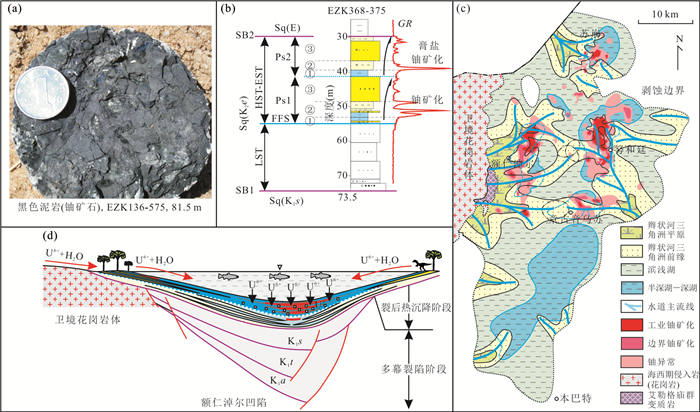
 下载:
下载:
